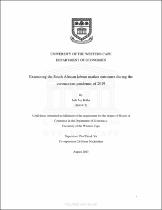| dc.description.abstract | The South African labour market is distinguished by dismally significant levels of unemployment and even higher levels of youth unemployment. The COVID-19 pandemic imposes the risk of adding further pressure on South Africa’s already exasperated labour market and thus contributing to greater unemployment levels amongst South Africans. To combat the effects of the COVID-19 pandemic, the South African government imposed lockdown levels to reduce socio-economic activities and thereby minimise the health effects and spread of the virus. The continuous lockdowns unfortunately placed constraints on business activities and led to increased levels of unemployment. The outcomes reveal that the burden of this unemployment resultant of the COVID-19 pandemic falls to minority groups, such as the youth, African women and lowly educated. This study analysed the 2020-2022 Quarterly Labour Force Survey data as well as the first five waves (also taking place in 2020-2021) of the National Income Dynamics Study – Coronavirus Rapid Mobile Survey (NIDS-CRAM) panel data to investigate who were the hardest hit in the labour market by the COVID-19-driven economic lockdown. The specific focus was on the profile of people (e.g., gender, race, age cohort, province, area type, educational attainment, work characteristics) suffering the greatest increase of unemployment during the abovementioned period, with the aid of various statistical and econometric analyses. The QLFS data showed that low-educated Africans aged 25-44 years and those involved in low skilled occupation categories were most susceptible to job loss. In addition, the NIDS-CRAM data showed that for those who were still employed in February 2020, just over 50% worked in all five waves, 14% worked in four waves and 9% in three waves. Only 0.5% and 1.8% turned out to be unemployed and inactive in all five waves, respectively. Finally, for the February 2020 employed who lost their jobs and became unemployed in April 2020 (wave 1), 60% of them worked again but 22% remained unemployed in March 2021 (wave 5). | en_US |

